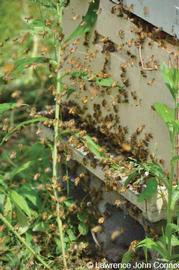 Heavy flight at colony entrance (likely orientation flights by workers); photo by Lawrence John Connor
Heavy flight at colony entrance (likely orientation flights by workers); photo by Lawrence John Connor
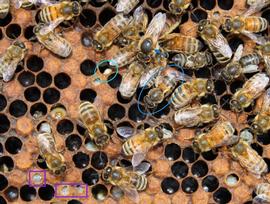 Spotty brood, uncapped pupal cells (purple boxes); worker bee with DWV (blue oval); dying larva known as snot brood (turquoise oval); queen without retinue (blue arrow); photo by Robert Snyder
Spotty brood, uncapped pupal cells (purple boxes); worker bee with DWV (blue oval); dying larva known as snot brood (turquoise oval); queen without retinue (blue arrow); photo by Robert Snyder
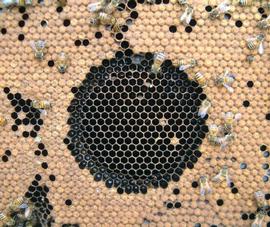 PMS test of rapidity of removal of pupae killed by liquid nitrogen; shows excellent removal by highly hygienic bees; photo by Robert Snyder
PMS test of rapidity of removal of pupae killed by liquid nitrogen; shows excellent removal by highly hygienic bees; photo by Robert Snyder
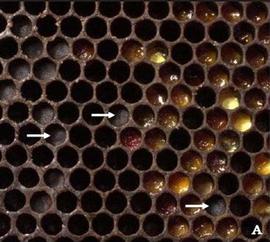 Entombed cells of bee bread; thought to be a way of avoiding pesticide poisoning; photo by BeeInformed Partnership
Entombed cells of bee bread; thought to be a way of avoiding pesticide poisoning; photo by BeeInformed Partnership
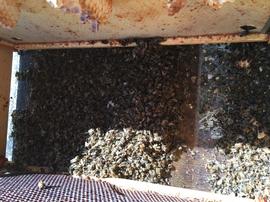 Heavy sudden death through pesticide kill; dead bees on screen bottom board; photo by Dewey M. Caron
Heavy sudden death through pesticide kill; dead bees on screen bottom board; photo by Dewey M. Caron
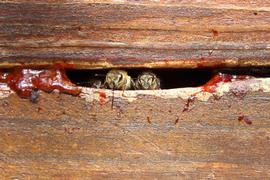 Propolis (reddish colored) used to close damage to wooden hive possibly due to mouse gnawing; photo by The BeeMD photo collection
Propolis (reddish colored) used to close damage to wooden hive possibly due to mouse gnawing; photo by The BeeMD photo collection
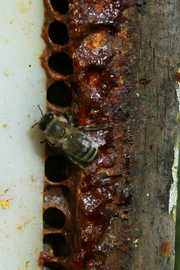 Bees using propolis to reduce hive entrance/exit holes to one-bee-size; photo by The BeeMD photo collection
Bees using propolis to reduce hive entrance/exit holes to one-bee-size; photo by The BeeMD photo collection
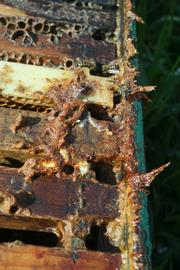 Propolis on rim of hive box; used to close area between box and upper box/hive covers; photo by The BeeMD photo collection
Propolis on rim of hive box; used to close area between box and upper box/hive covers; photo by The BeeMD photo collection